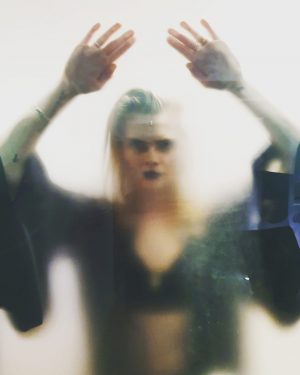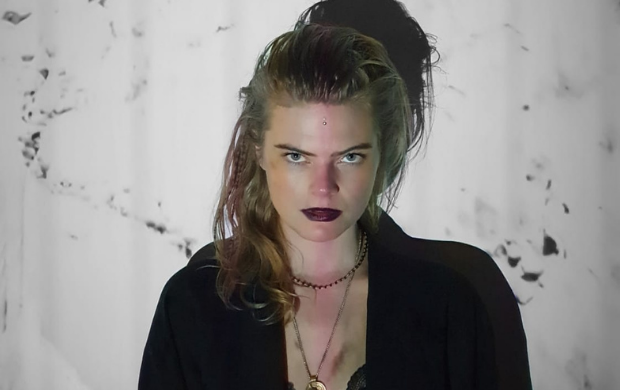Hi Steinsdotter, you’re known for being a musician, performance artist and a practicing Norse witch. What’s an average day in your life like?
I love to wake super early like 4 AM and to begin my morning ritual before the morning actually comes. It feels like the most peaceful time of day; stolen time just for myself. I’ve been like this since I was a child. Cherishing the contemplation of the early hours.
I spend most of my time singing, playing drums, writing, studying – and obsessing over nature’s details and mysteries, whilst developing new ideas that excite me. Despite its difficulties, Lockdown has gifted me plenty of time to learn, think and explore.
My studio is close to the woods, which is one of my favourite things about it. I love walking in the forest and feeding the crows barefoot. That is where I collect myself and find new strength and inspiration. The trees have bestowed many melodies upon me this year and held space for me throughout all the chaos.
Can you tell us a bit about your journey and what inspired you to develop your many crafts?
Leonard Cohen was my greatest inspiration during my teenage years. The first time I read his poetry that was it. I’ve never stopped writing since. I’ve always had a very curious mind that was keen to observe and that compelled me to experience the new and unknown.
I left home when I was fifteen years old because I wanted to become an artist. And I’ve been obsessing over this life ever since. I always had an intuition I would come to the U.K. There was something calling me to it, something I can’t really put my finger on.
When I first discovered that I was related to a Viking witch (a Völva) who’s majik staff and remains are in the British museum, it opened my mind to the ancient culture of the Norse. I felt like I was falling in love with two cultures at the same time. Everything fell into place.
Knowing about her existence is very reassuring. Her story intrigues me endlessly. Who was she and what hardships did she encounter on her journeys? Knowledge of her struggle has given me perspective. I love making music with her in mind. And she was definitely the one who inspired me to walk the path of Seiðr.
She also taught me that it is okay to belong to more than one place, as long as you belong to yourself first. And this has helped me find my voice as an artist and inspires me to experiment with a variety of instruments and to find new melodies to express myself.
You’re about to release an EP, Blood Eagle, which refers to an old Norse ritual of execution. What was your inspiration for the work?
I’ve been working in the studio for several years, developing my sound. Exploring my psyche, my poetry, my voice. I desired a life of mystery and surprise, despite the potential lack of comfort and the sacrifices this life would demand, so I wouldn’t have it any other way. In true Viking spirit I abandoned my homeland, to sail across the ocean with a solitary suitcase and big dreams, full of music.
The blood eagle is a ritual method of execution, detailed in late skaldic poetry. According to the two instances mentioned in the Sagas, the victims were placed in a prone position, their ribs severed from the spine with a sharp tool, and their lungs pulled through the opening to create a pair of “wings”. The recipient of this torture was expected to remain silent throughout it, or lose their place in Valhalla.
It felt fitting to title the E.P Blood Eagle because this work has been a personal ritual for me. I resonated with the idea of brutal catharsis in the hope of transcendence to another reality. My Blood Eagle is the culmination of each tough choice I have made to arrive at this moment. The desperate moves for survival in a new city, the isolation and the fear of the unknown, the literal hunger when I’ve had nothing to my name. I’m ready to let this past go, to move on from it’s indignities and harsh lessons. I’m ready for a transmutation, the acceptance of my faith.
You practice Seiðr. What does that entail and how do you use it in your day to day life?
Seiðr is an ancient old Norse shamanic practice. Legend tells us the goddess Freya actually taught the mighty Odin the arts of Seiðr. It is a very intuitive way of living and practicing. I’m sure if you asked a group of Seiðr seekers what their daily routines look like the answers would be so varied they would intrigue, but frustrate those looking for concrete definitions. That is the beauty of Seiðr in my eyes. There is endless possibility everywhere and it is incumbent upon your own mind, discipline and imagination to grasp the deeper meaning from the subtle forces acting on your senses. You are the interpreter of an obscure and ancient language, one our ancestors were much more aligned with.
Seiðr has taught me to pay attention to all the esoteric things in life and in nature. Within myself and outside of myself. Everything has a place, a rhythm, a purpose. How things push and pull, how everything that goes up must come down, there is a certain rhythm to it all, a balance, if you open yourself to it.
Seiðr gives a mindfulness to how you live and how you interact with the processes of life and death. The only way to live well is to love well in my eyes. And to master that you need to understand yourself first. Come home to yourself. Trust yourself. That is when you can be at service to others with an open heart and a hungry mind.
When I channel songs, I’m always welcoming voices from different dimensions to surround me. I want to hear them, I want to learn from them, I want to go on a journey with them. Seidr allows me to be connected to those energies when I create and be liquid in how I think. And more than anything else, this heightened awareness of life brings me so much joy on a daily basis.

Many people today are drawn to ancient forms of spirituality, especially with the success of shows like the History channel’s Vikings. Why do you think we’re so fascinated by these stories?
I think the idea of ultimate freedom is what we are all so drawn to, the freedom of a mythical reality full of wonder, good and evil comprehended through archetypal absolutes. We want to feel the potency of a life completely connected to the elemental forces; the strength; the independence they represent. The explorer spirit. Not cocooned in modern convenience, but caught up in pure survival, the exaltation of acquiring skills and knowledge and battling fearlessly.
More than anything else, we desire a meaningful life purpose and an even stronger death purpose! Dying well was very important. And, I think it still is so much more important than we allow our contemporary minds to ponder.
A lot of people secretly wish to be Vikings because they are actually living a life that makes them feel restricted. Maybe they feel like they are missing out somehow. So getting lost in these ancient mysteries is very appealing to our inner animal spirit that just wants to roam around free.
What do you think it is about the modern world that makes us want to draw wisdom from pagan ways of life?
We feel belonging in the stories we are told that have passed through generations. The modern world is a busy place full of fear and scarcity, yet with empty promises of a golden, abundant land everywhere you turn. We are trained to look outward for solutions and acceptance, rather than to feel within, to contemplate, think deeply, to be connected. We have taken on some pretty damaging habits and attitudes as a species. I think the pagans’ connection to nature, constantly living in sync with the environment in order to survive, is something that speaks to us on a human level through all the chaos. We want to be better. We feel inspired by their wisdom. We want to connect to it again, to not feel alienated from our planet.
Do you think that science and spirituality can complement each other?
Absolutely. In fact I’m pretty excited to see what the future brings when we are able to comprehend the parallels between the two, rather than denying they have any relation at all. When I reflect on this balance I think of Ancient Egypt – how as a society they mastered the combination of the two and the mark that left on this world. Their culture was rich and dynamic. We still don’t understand a great deal of the wisdom they left behind. There is definitely something to learn from the past in order to achieve the advanced societies we imagine in our future.
Tell us something positive you’ve learnt from the last year..
I’ve learned that people are adorable and beautiful when they clumsily come together in a crisis and try and help each other out the best they can.
What’s next for you and your work?
I’m excited to continue experimenting with music. I can’t wait for the EP to be out so you can hear it! I have some really exciting collaborations happening this year. Of course, I dream about doing live gigs again when the world opens, to feel that energy boost of a crowd coming together. But for now, it’s only a dream or maybe a memory.










